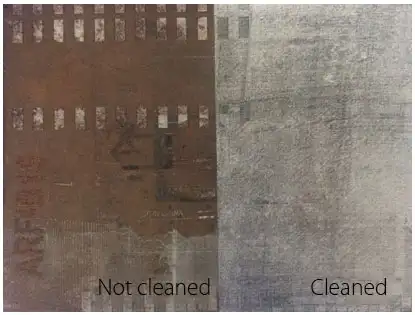The MaxPulse100W laser cleaning process
Molds, weapons and equipment, precision machinery, the electronics industry, often need to remove products, equipment, surface rust, oxides, pollutants. The traditional chemical or mechanical way to remove incomplete, damage to the matrix material defects, by contrast, laser cleaning is a green, flexible and efficient way to clear, to ensure the removal effect, while almost no damage to the matrix material , Can be flexible to deal with a variety of shapes and sizes, low power consumption.
Principle and Application of Laser Cleaning
Laser cleaning is based on the photophysical reaction between the laser beam and the pollution layer. There are two main ways of laser cleaning: First, the laser is absorbed by the pollution layer on the surface of the material. First, the plasma is formed by the laser, and the shock wave, shock wave So that contaminants become debris and be removed.
Laser cleaning can not only be used to clean organic pollutants, can also be used to clean inorganic, including metal corrosion, metal particles, dust, can be used for mold cleaning, cleaning equipment, electronic industry, precision machinery cleaning, cultural relics Cleaning and so on.
MAX Pulse 100W Laser Cleaning Case
Using the MAX Pulse 100W pulsed laser developed by Chongxin Laser, it can realize the high-speed cleaning of the pollutants on the surface of the material without damaging the matrix material.
Product description
It is suitable for the precision machining of stainless steel, copper, aluminum and other materials. It has small thermal distortion and high processing precision. It has the characteristics of narrow pulse width and high peak power. Its compact structure, easy system integration.

The main factors affecting laser cleaning are laser power, pulse frequency, laser scanning path, scanning fill spacing and so on.
Laser power, pulse frequency
The main factors influencing the laser power density were compared with the cleaning effect under different conditions. In order to achieve the optimal cleaning effect, the higher frequency power parameters are preferred. In the experiment, the cleaning area is 40mm × 40mm rectangular area, galvanometer fixed, scanning speed 6000mm / s.


The cleaning area in the picture corresponds to the position in the table above


The cleaning area in the picture corresponds to the position in the table above
Experimental conclusion:
a) The laser power is invariable. With the increase of the pulse frequency, the damage of the cleaning area is reduced;
b) Laser frequency is constant, with the laser power increases, the cleaning area damage increased;
c) Experiments show that, under the above parameters, can completely remove the carbon steel surface rust;
d) Compared with one time, the damage of the matrix showed an increasing tendency, and it was not obvious when the power was 50%;
e) From the above experiment, 50%, the best cleaning effect, and the second cleaning and a cleaning difference is not large, taking into account the follow-up manual moving speed, choose a clean A3 process。
The Effect of Laser Scanning Path
Four laser scanning paths are preset as follows.
Software default scan path (four)




(a) (b)(c)(d)
On the basis of the above experiment, choose the best process parameters, change the spot pattern.
The cleaning effect is shown below:

You can see the scan mode(a)、(c) 、(d)Cleaning effect is relatively good,(c)The effect is slightly worse.
The effect of scanning the fill spacing
Keep the other process parameters unchanged, change the laser scanning fill spacing.

It can be seen that as the filling distance becomes larger, the surface color of the substrate after washing becomes darker and the surface cleaning effect becomes worse. While the pitch becomes smaller, the matrix appears burning yellow.
Laser cleaning effect
The scanning speed is 6mm / s ~ 7mm / s, the laser power is 50% ~ 60%, the pulse frequency is 160KHz, the scanning speed is 6000mm / s, the scanning filling is 30mm × 0.2mm, the scanning speed is 6mm / s ~ 7mm / s, Spacing 0.10mm, laser scanning path as shown in the path diagram (a).
Typical cleaning results are shown below.

MAX Pulse 100W pulsed fiber lasers with narrow pulse width and high peak power can easily cope with the cleaning requirements of the surface of various shapes and sizes.




